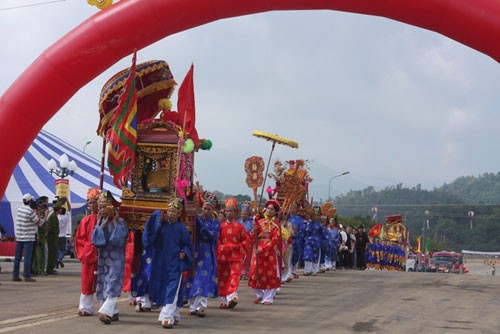(VOVworld) – 5 years ago, Hanoi was expanded, to cover Ha Tay province, Me Linh district of Vinh Phuc province and 4 communes in Luong Son district of Hoa Binh province. The expansion enhances the capital city’s profile during its new development period, but poses social management issues. How to protect the cultural essence of Doai area, which includes parts of Ha Tay, Vinh Phuc and Hanoi? VOV looks for the answer.
|
|
| Thang Long Royal citadel, a world heritage site |
Hanoi is home to many famous historical relic sites such as Thang Long Royal citadel, the old quarter, the Restored Sword Lake, One Pillar Pagoda, and the Temple of Literature. The city is also best known for its intangible cultural heritage such as ca tru or ceremonial singing, water puppetry, and the Giong festival. As Hanoi has expanded, it came to incorporate the 2 major cultural areas of the northern delta: the capital city and the Doai area. The Doai area boasts a great deal of heritage, including Duong Lam ancient village, Huong pagoda and Tay Phuong pagoda, traditional handicraft villages, Do singing and Cheo Tau (traditional opera). To date, Hanoi has the largest number of relic sites – 5,300 – of which 2,100 sites are recognized and more than 1,000 festivals out of the total 8,000 festivals in Vietnam. This is the pride of Hanoians, but requires more responsibility by the culture sector for preserving and promoting this heritage. Phan Dang Long, Deputy Head of the Department of Communication and Education under Hanoi’s Party Committee, told VOV: “Many people argue that given the process of development and integration and the intertwinement of the cultures of different regions, including Hanoi and the Doai area, will the culture of the capital city fade out? But, reality has shown that the culture of Thang Long-Hanoi and the Doai area retains their distinctive features amidst the common development of the new Hanoi”.
 |
| A festival of traditional handicraft villages |
Le Thi Tan Trang, Deputy Director of Hanoi’s Department of Culture, Sports and Tourism, told VOV: “We compare the cross-culture with circles on the surface of the water, which move when being disturbed. So, culture and cultural identities are diverse in their unity. Hanoi is the meeting place of national cultural quintessence. Cross-culture has not occurred since Hanoi’s expansion but earlier when people from all over the country came to settle in the capital. This helps enrich the thousand-year-old culture of Hanoi”.
Beauty spots as well as historical and legendary relic sites along the Red River are linked to mythical sites related to Tan Vien mountain in Ba Vi. Hanoi’s old quarter is associated with traditional handicraft villages on the outskirts of the city. Together they have all formed a complete network of cultural, spiritual and ecological tours. Ha Xuan Hung, Secretary of Ba Vi district’s People’s Committee, told us: “We are keen on restoring and preserving relics, which number more than 300 in our district alone, of which 70 have been recognized at national and municipal levels. They are Ba Vi’s precious assets. In accordance with the city’s instructions, we will do our best to promote these relics, contributing to the preservation of national cultural values”.